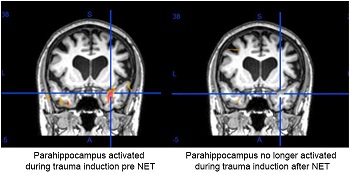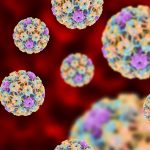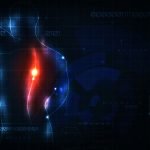Subconscious Healing: Two Case Studies Highlight the Mind-Body Connection
SHAWNA EISCHENS, ND

Look at that fresh lemon! As the knife slices through it, notice the spray of juice and the intensified aroma. Squeeze a section of this juicy, sour fruit into a glass of lemonade, and then imagine biting into the remaining lemon before drinking the tart lemonade.
Are your lips moving or do you notice an increase in salivation? If so, you are experiencing a normal physiological response. As our mind recalls past memories or events, physical reactions can re-occur without an actual stimulus being present. This interconnected relationship between our brilliantly designed body and mind is not only fascinating; it is also a causative or contributing factor in many phobias, “stress” reactions, and even physical symptoms, the latter of which this article mainly focuses on.
Your mind is in every cell of your body. (Candace Pert, PhD)
Emphasizing intellect over intuition, focusing solely on physical health, and ignoring the power of our thoughts and subconscious beliefs can be detrimental to helping ourselves or our patients fully heal on all levels. An estimated 95% of our thoughts, emotions, and behaviors happen without our conscious awareness. We would be foolish to neglect the majority of our operating system and not acknowledge the role that our experiences, beliefs, and unprocessed emotions play in our daily health.
Neuro-Emotional Technique
This article, in addition to many examples of profound healing in my clinical practice, would be nonexistent had I let my own conscious and sometimes stubborn or intellectual mind override the possibility of something greater. Previously, my limited mindset had assumed that physical symptoms such as pain, nausea, bloating, headaches, dysmenorrhea, tics or tremors, sinus pressure, or dermatitis were caused solely by physical issues. While diet, microbial imbalance, toxicity/poor detoxification ability, neurological concerns, or structural misalignment can play a role in the above symptoms, they are only part of the puzzle for many patients. I have clinically observed all of the above symptoms to improve through a modality that helps process unresolved, unconscious stress. I can relate to those who are skeptical, as it took multiple personal, positive shifts with Neuro-Emotional Technique (NET) to turn my complete doubt into “healthy skepticism” before enrolling in the NET certification course.
As I sat in the audience of practitioners at my first training course, I watched a live demo of a young, vibrant female with chronic left shoulder pain, limited range of motion, and palpable and audible crepitus near her superior scapula. I can still recall my silent, doubt-filled thoughts:
“There is no way to instantly resolve crepitus.”
“How could this really resolve chronic pain, much less immediately or long-term?”
“I wonder if she’s tried x, y, or z yet for her pain?”
Over the next few minutes, the NET demonstration uncovered and resolved this person’s suppressed, unconscious feelings since being unable to help out her parents after her dad’s shoulder surgery. Much to my surprise (and disbelief), this person immediately reported NO pain and increased range of motion, and neither she nor the practitioner were able to palpate or hear the crepitus that was observed minutes earlier. I was amazed, yet still thought it was too good and too easy to be true, so I silently observed how this person moved throughout that training weekend and those that followed.
At the final course, many months later, I made a point to ask her about her shoulder. She paused, as she had forgotten about it, and then happily stated that it was normal since participating in that original session. This was a profound moment highlighting how strong (ahem, stubborn) our conscious mind can be in limiting the potential of deep, long-lasting healing. I shared my skepticism with her, then asked if I could share her story in the future. She consented.
Your perspective is always limited by how much you know. Expand your knowledge and you will transform your mind. (Bruce Lipton, PhD)
As naturopathic physicians, our patients are seeking answers, especially those who have seen various practitioners or “tried everything” without noticeable improvement. The answers lie in finding the cause, to eliminate the obstacles to healing. Suppressed emotions are stored in the body and, until released, can contribute to physical symptoms that are frequently misinterpreted as solely structural or pertaining to the physical body. Supplementation or medication cannot cure a person with unresolved trauma. It is essential to understand that these patients are not crazy or malingering, but rather need an opportunity to release this stuck emotion that their body is holding onto through physical and emotional symptoms.
NET helps to identify and remove neurological imbalances related to the physiology of unresolved stress. These changes can be felt immediately, and most patients use the word “lighter” to describe how they feel subjectively after a treatment. Studies have shown via fMRI that areas of the brain associated with perceived emotional trauma can heal, even with the same stressful trigger present (Figure 1).1
Figure 1. Brain Response to Trauma, Pre- & Post-NET

These objective findings show the neurophysiological and clinical effects of the physical and mental/emotional healing that can occur when a stuck or unresolved stress pattern is released. If we can change our brain through changing our perception, imagine the potential of drastically changing our health through changing our thoughts. NET happens to be the technique that I prefer to use, but please know that there are many effective techniques to help heal the unconscious mind to decrease stress, improve health, and resolve limiting thoughts or harmful behaviors. These include but are not limited to: hypnosis, Psych-K, Emotional Freedom Technique (EFT), Somatic Experiencing, meditation, and Body Talk.
The following case studies are designed to offer hope while highlighting how our past perceived experiences, stressors, and thoughts play significant roles in our current physical, mental/emotional, and spiritual health. With any hands-on treatment, reading doesn’t compare to visually observing or being a participant; therefore, live NET demonstrations are available on my YouTube channel or at netmindbody.com for those who wish to observe a session. If your conscious neocortex desires specific research or details about psychoneuroimmunology, neuroscience, or physiology that is incorporated in subconscious techniques, I recommend looking at the work of Candace Pert, PhD, Joe Dispenza, DC, or Bruce Lipton, PhD.
Case Study 1
A 60-year-old female patient was referred to me by a colleague after she had previously been diagnosed with Meniere’s disease at a prestigious conventional medical facility in late 2019. The patient’s symptoms were intermittent and variable but also quite bothersome, as they affected her ability to focus, hear, drive, and write. She never knew when the vertigo, vomiting, or tinnitus might return with a vengeance, as it was known to do.
At our first appointment together, she reported mild vertigo, intense left ear ringing, and severe brain fog that made it difficult to focus. She had already tried many different treatments and supplements, but none that incorporated her subconscious mind or made a significant impact. She was open to exploring this new approach, as she was frustrated by her daily symptoms. So we proceeded with her first NET treatment.
After trying out a few different statements, the following were found to be incongruent with her unconscious mind: “I deserve to be without these symptoms.” “I’m OK healing.”
Both statements were separately found to be related to the suppressed emotion of shame. The first statement related to an event where she felt unworthy of being loved shortly after her husband had passed away. If we feel unworthy, it makes sense that deep down we don’t feel like we deserve to be symptom-free. The second statement was found to be related to feeling bad about being unable to fix something after a sibling was born when she was 9 years old. If we have issues with being unable to change or fix a situation, of course we’re going to feel bad if we can’t fix our own health.
After processing these 2 statements, she immediately felt better, and was excited to see what else might be involved. I asked her to place her finger in her left ear and focus on her tinnitus. During the process, the symptom was determined to be related to more than just a physical issue. Once again, shame was the suppressed emotion, this time from an original event that left her feeling that something was wrong with her. As she recalled this event where she felt excluded from people very special to her, the emotional flood-gates opened and her tears flowed freely as she released this unprocessed trauma. When she completed the session, she reported feeling lighter, with less tinnitus, no vertigo, and no foggy distraction in her head, all of which she felt at the beginning of her appointment.
For the 3 days following our session, she observed drastic improvements. On day 4 she noticed a sensation of her brain “shifting or swimming in empty head space” as well as an increase in her tinnitus and difficulty hearing. After some reflection, she became aware of the date: it was the anniversary of her husband’s death. She was now consciously aware of the powerful mind-body connection.
During the next few appointments, this patient was motivated to resolve various concerns, including negative thoughts about her body, stress surrounding challenging relationships, the aforementioned “head swimming” feeling, and a sensation of needles shooting out of her heart region. As she addressed these issues, her symptoms subsided.
Currently, she is thrilled to have a life without vertigo or other bothersome physical sensations. She can hear well, and her head is clearer than it has been in years, allowing her to think easily. The tinnitus that was present for 30 years is barely noticeable, and she reports feeling less lonely or excluded, and more content and accepting of herself and others.
Case Study 2
A 38-year-old female presented to my office with gastrointestinal distress and symptoms of acute illness. At her initial appointment, she shared that she was afraid to eat because of the digestive distress and pain caused by eating, and she was concerned about the 4-7+ days each month when she would notice acute symptoms, including but not limited to sinus congestion, throat pain, and vertigo. Daily nausea was her biggest concern at the first appointment, but this resolved after a hiatal hernia manipulation, avoiding her food intolerances, and beginning daily homeopathic Arsenicum album 12c.
Due to her abusive childhood and the fact that she had plateaued in healing while using self-prescribed supplements and/or psychotherapy, she was willing to explore at her next appointment the role that her unconscious mind might be playing in her symptoms. During the treatment, it was clear that her subconscious was not in alignment with the statement, “I’m OK without pain.” In other words, her internal belief was that she was not OK without pain. This is a setup for a life with chronic pain unless something is done to shift this underlying belief. After identifying the core issue of feeling unsupported following an emotional event at 15 years of age, she was able to process that unresolved issue to move past her limiting belief.
At her follow-up visit, she was excited to report a much larger appetite, more energy, no nausea, no GI pain, less anxiety, and no episodes of vertigo. One week after her follow-up, she called to express concern about her symptoms, and asked for a COVID test. She came into the office with a cough, sore throat, headache, fatigue, chills, vertigo, and lightheadedness. She was unable to take deep breaths and felt short of breath.
Her vital signs were optimal, and a thorough physical exam revealed no positive findings. I told her that I believed that she was having these very real physical symptoms but also that there were no apparent signs of any acute physical illness. Fortunately, she was open to exploring the possibility of an emotional connection to the acute physical symptoms that she had been experiencing monthly. She didn’t need a supplement or medication to heal, and she didn’t need to be dismissed as delusional; rather, she needed an opportunity to process stuck emotions from the past so that she could move forward with less stress and better health.
The following statements were found to be incongruent between what her conscious vs subconscious mind believed to be true:
- “It’s good for me to breathe easily.” This event was correlated with a specific time in her life when she felt that something was her fault, resulting in a lack of fulfilling friendships. Following the NET session, she noticed an immediate improvement in her ability to breathe freely and deeply.
- “I’m ready, willing, and able to break this cycle.” This wording was chosen based on the patient’s reoccurrence of symptoms of acute illness every 3-4 weeks. This statement was found to be correlated with a perception of being unsupported by a friend from her past. Immediately after the treatment, she recalled that these recent symptoms started after feeling unsupported during a major milestone of buying a home and moving. This was a profound moment for her, as she was able to consciously connect to this unconscious issue that had been affecting her negatively.
After processing these 2 statements, she reported that her symptoms were 100% resolved and that she felt great. This was accomplished in less than 30 minutes and without the need of any additional remedies, supplements, needles, medication, or guesswork, simply by balancing the subconscious mind and allowing past, blocked emotions to be resolved. This work isn’t magic, but it can have magical results.
Four days later, she stated, “I have felt amazing since the last appointment. I haven’t felt this free, productive, or energized in as long as I can remember. I could have torn up that list of symptoms I wrote down last time, as I haven’t had any of that since the work we did. I have had some great therapists over the years, but I have never felt anything so instant and deep as what we did.”
Beliefs and thoughts alter cells in your body. (Bruce Lipton, PhD)
Closing Comments
Over the course of writing this article, patients with debilitating physical symptoms from multiple chemical sensitivity, dysmenorrhea, neck or back pain, and migraines have noticed life-changing improvements from being open to the potential that their physical concerns may be related to their perceived and unresolved subconscious trauma from past events. I commend these patients and all of us who are expanding our perception while allowing the subconscious to be heard and to heal. It is an honor to work with those who are ready to improve their health, life, and the world around them simply by changing their perception.
The moment you change your perception is the moment you rewrite the chemistry of your body. (Bruce Lipton, PhD)
References:
- Monti DA, Tobia A, Stoner M, et al. Neuro emotional technique effects on brain physiology in cancer patients with traumatic stress symptoms: preliminary findings. J Cancer Surviv. 2017;11(4):438-446.

Shawna Eischens, ND, (“Dr E”) is an expert in working with the body to help resolve challenging issues, so that patients can thrive instead of just survive. She is licensed in Minnesota and Arizona, but treats patients primarily at Rockwood Natural Medicine Clinic, in Scottsdale, AZ. Dr E is a passionate educator, speaker, 2012 graduate of Southwest College of Naturopathic Medicine, volunteer for Big Brothers/Big Sisters and the Naturopathic Medicine Institute, and nature enthusiast. Learn more about Dr E at her YouTube channel or at www.drshawnae.com.









